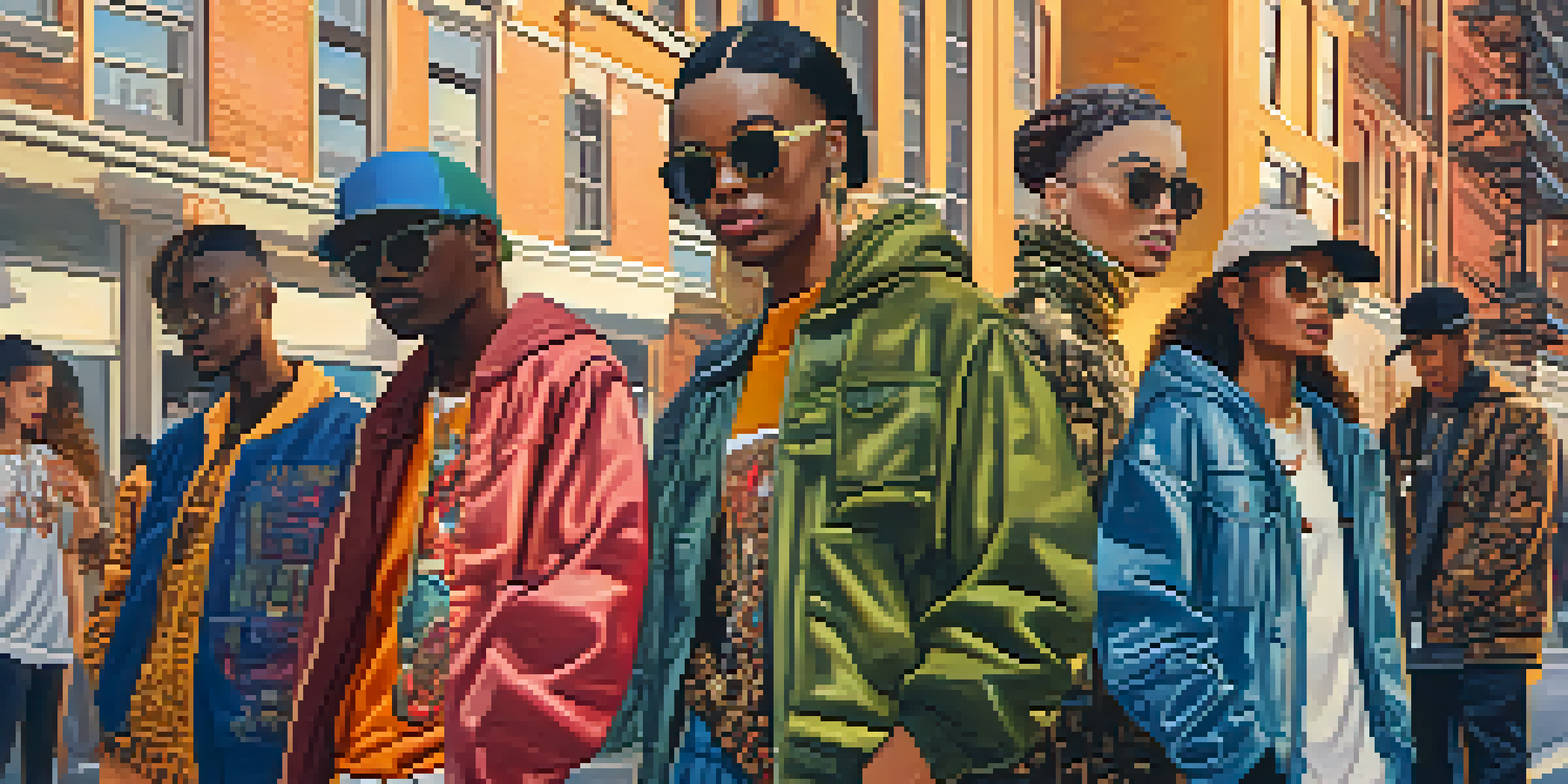Social Media Influence: Fashion Trends Beyond the Digital Divide

The Rise of Social Media in Fashion Trends
Social media has transformed the way we discover fashion, offering a platform where trends can emerge and spread rapidly. Influencers on platforms like Instagram and TikTok play a pivotal role, showcasing styles that can go viral overnight. This immediate access to new fashions allows consumers to feel more connected to trends, bridging the gap between digital and physical styles.
Fashion is the armor to survive the reality of everyday life.
For instance, consider how a simple outfit post can lead to a surge in sales for a particular brand. When a popular influencer wears a specific piece, it can become the must-have item of the season, illustrating the power of social media in dictating fashion choices. This phenomenon demonstrates how quickly trends can evolve in our interconnected world.
Moreover, brands are increasingly leveraging social media to gauge consumer interest before launching new lines. By observing which styles get the most likes, shares, and comments, they can tailor their offerings to meet the demands of their audience. This has created a more responsive fashion industry, one that is continually adapting to the tastes of its consumers.
Influencers as Trendsetters: A New Era
Gone are the days when fashion trends were dictated solely by high-end designers and runway shows. Today, influencers have become key players in this landscape, often setting trends that resonate more with everyday consumers. Their authentic connection with followers fosters a sense of trust, making their fashion choices influential.

Take the example of streetwear, which has exploded in popularity largely due to influencers who blend high fashion with casual styles. This shift highlights how social media has democratized fashion, allowing anyone with a unique sense of style to impact what others wear. The idea that fashion is for everyone, not just for the elite, has become a common narrative.
Social Media Transforms Fashion Trends
Platforms like Instagram and TikTok allow trends to emerge rapidly, connecting consumers with new styles instantly.
Furthermore, influencers often prioritize relatability over unattainable luxury. By showcasing affordable looks and styling tips, they make fashion accessible, encouraging their followers to express themselves without breaking the bank. This approach reinforces the idea that personal style is more about self-expression than adhering to traditional fashion norms.
From Digital Trends to Real-World Impact
The influence of social media on fashion extends beyond likes and shares; it has tangible effects on real-world shopping habits. Many consumers are inspired by what they see online, leading them to seek out similar styles in physical stores. This crossover highlights the importance of a cohesive online and offline shopping experience.
Style is a way to say who you are without having to speak.
For example, the popularity of 'Instagrammable' outfits has led brands to create collections that cater specifically to this audience. Retailers often use social media insights to curate their inventory, ensuring they stock items that resonate with current trends. This synergy between digital influence and retail strategy has changed the way fashion is marketed.
Moreover, events like Fashion Weeks are now closely tied to social media coverage, with live streams and posts dominating conversations. This immediacy allows consumers to engage with collections in real-time, making the fashion industry feel more inclusive. It’s fascinating how the digital space can directly affect buying decisions and fashion culture in everyday settings.
Sustainability and Social Media's Role
As consumers become increasingly aware of sustainability issues, social media has played a crucial role in promoting eco-friendly fashion trends. Influencers are now using their platforms to advocate for sustainable brands, encouraging followers to make conscious choices. This shift is not just about style; it’s about fostering a culture of responsibility within the fashion industry.
For instance, the rise of thrift-flipping and upcycling is largely attributed to social media challenges that encourage creative reuse of clothing. These trends highlight the importance of sustainability while providing a platform for personal expression. It’s a powerful example of how fashion can evolve to meet ethical considerations without sacrificing creativity.
Influencers Redefine Fashion Authority
Influencers have become key trendsetters, promoting relatable and affordable fashion choices that resonate with everyday consumers.
Furthermore, brands that prioritize sustainability in their marketing often gain a competitive edge, as consumers are more likely to support companies that align with their values. This creates a ripple effect, where social media not only highlights the importance of eco-friendly practices but also drives demand for sustainable fashion solutions. The future of fashion is increasingly intertwined with social responsibility.
The Role of User-Generated Content
User-generated content (UGC) is a powerful tool in the fashion industry, as it allows consumers to participate in the narrative. When followers share their outfits inspired by influencers, it creates a sense of community and belonging. This interaction fosters loyalty and encourages others to engage with the brand or trend.
Brands often showcase UGC on their platforms, amplifying their reach and authenticity. Seeing real people wearing the same items can be more relatable than traditional advertisements, making consumers more likely to purchase. This shift towards inclusivity highlights the importance of diverse representation in fashion.
Additionally, UGC encourages creativity, as consumers feel empowered to express their unique styles. This can lead to a diverse array of fashion interpretations, as people put their spin on trending looks. The result is a rich tapestry of fashion that reflects a variety of backgrounds and perspectives, thriving on the collaborative nature of social media.
Challenges of Social Media in Fashion
While social media has opened up new avenues for fashion trends, it also presents challenges for both consumers and brands. The fast-paced nature of trends can lead to a cycle of overconsumption, where individuals feel pressured to constantly update their wardrobes. This can be overwhelming and unsustainable in the long run.
Moreover, the curated nature of social media can create unrealistic beauty standards, making some consumers feel inadequate. The constant comparison can lead to negative self-image, prompting a need for the industry to promote authenticity and body positivity. It's essential for brands to recognize the impact of their messaging on their audience’s self-esteem.
Sustainability Shapes Fashion Choices
Social media promotes eco-friendly practices, encouraging consumers to support sustainable brands and fostering a culture of responsibility.
Additionally, misinformation can spread quickly on social media, leading consumers to make poorly informed fashion choices. It’s crucial for brands and influencers to foster transparency about their products and practices. By prioritizing honesty, the fashion community can work towards a more informed and responsible consumer base.
The Future of Fashion in a Digital World
As we look to the future, it's clear that social media will continue to shape fashion trends in profound ways. Emerging technologies, such as augmented reality (AR), will likely enhance the shopping experience, allowing consumers to visualize how clothing will look on them before making a purchase. This innovation could bridge the gap between online and offline shopping even further.
Additionally, the rise of virtual fashion shows and digital clothing is on the horizon, offering new avenues for creativity while reducing the environmental impact of traditional fashion events. This shift could change the way we perceive fashion, focusing on digital expression rather than physical garments. It’s an exciting time to be a part of the fashion world.

Ultimately, the key to a successful future in fashion lies in balancing innovation with sustainability and authenticity. As social media continues to evolve, it will play a critical role in shaping not only trends but the values that underpin them. The relationship between fashion and social media promises to be dynamic, reflecting the diverse voices of consumers along the way.